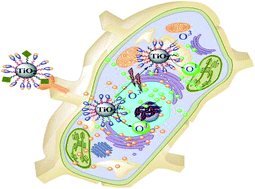Targeted photoresponsive TiO2–coumarin nanoconjugate for efficient combination therapy in MDA-MB-231 breast cancer cells: synergic effect of photodynamic therapy (PDT) and anticancer drug chlorambucil†
Abstract
Coupling of photodynamic therapy (PDT) with chemotherapy is an emerging treatment modality because of its ability to improve the antitumor effect and reduce the toxicity of the anticancer agents. Metallic NPs, silica NPs and carbon nanotubes have become rising stars as drug carriers for both photosensitizers and chemotherapeutic agents. But to date there are only a few reports using the aforesaid NPs as a platform for PDT combined with chemotherapy. Hence, we have developed a targeted metallic single nanoparticle system for the amalgamation of PDT with chemotherapy. The NPs for combination therapy have been constructed using two main ingredients: folic acid decorated TiO2 NPs and coumarin chromophore. The newly synthesized coumarin chromophore performed three important roles: (i) being a fluorophore for cell imaging, (ii) photosensitizer for PDT and (iii) a phototrigger for regulated anticancer drug release. Furthermore, folic acid decorated TiO2 NPs help with internalization of the drug to inside the cancer cells. In vitro biological studies reveal that this targeted combination treatment results in an enhanced tumor accumulation of TiO2 nanoparticles, significant inhibition of tumor cell proliferation and increased induction of apoptosis. Such metallic photoresponsive NPs that are benign to the physiological system, permeate easily into cells and exhibit high therapeutic efficacy, will have significant prospects for use against drug-resistant tumors.


 Please wait while we load your content...
Please wait while we load your content...